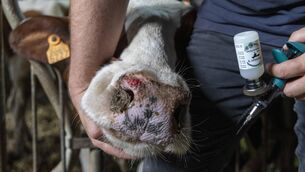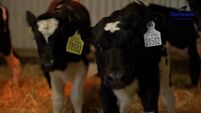Farmers first to spot a good deal, says banker after fast uptake of €150m loans

Banker Nick Ashmore has praised the agriculture community for being “incredibly financially savvy and interest rate sensitive”.
The Strategic Banking Corporation of Ireland chief executive was commenting on the fast uptake by farmers of the €150m agriculture cashflow support loan scheme.
“They are the first to spot a good deal that helps them, and they just went for it,” Mr Ashmore told the recent Joint Oireachtas Committee on Agriculture, Food and the Marine debate on the Loan Scheme.
It was launched by Agriculture Minister Michael Creed at the end of January, and the three banks involved confirmed recently that all of the €150m is committed, and is being drawn down.
A breakdown of the €60.2m already drawn down in 1,859 loans up to the end of April showed 22%, or €13.2m, went to farmers in the SouthWest.
“It did catch us by surprise, I have to say, and I think it caught the banks a little bit by surprise as well,” commented Mr Ashmore on the speed of loan uptake.
He revealed that the 2.95% interest rate, fixed for the life of the loan, compares with rates of between 6% and 14% for alternative products such as overdrafts, standard variable loans and merchant credit.
“Bank overdrafts are 9% to 12%, the Glanbia MilkFlex fund is about 4.2%, and merchant credit is anywhere between 9% and 10%, up to 14%. This is quite insidious, because many farmers do not actually realise what they are paying in that context.
“Standard variable rates average somewhere around 6% or 6.5%,” said Mr Ashmore.
He said borrowers remain wary of banks.
“We are still seeing the SME community as a whole, including farmers, pay down debt at a very rapid rate.
“There is still wariness regarding being in debt to the banks for longer periods.”
“We think there may be a fair proportion of farmers who would only have applied for shorter-term loans because they do not want to be looking over their shoulders for the next six years.
“They would rather go in, get what they need and get out again.”
He confirmed that the three banks involved — AIB, Bank of Ireland and Ulster Bank — are specifically not generating any extra profit out of this scheme.
“This is designed to be cost-neutral for the banks. That is very important for state aid rules.”
The loan scheme was built off state aid from the European Commission for livestock farmers.
In the scheme, unsecured loans of up to €150,000 per farm were offered for up to six years, with optional int
erest-only repayment periods. They were designed to allow farmers pay down more expensive forms of short-term debt, thus ensuring the ongoing financial sustainability of viable farming enterprises.
Since March 2015, the SBCI, working with eight front-line lending institutions, has supported over 12,500 SMEs with over €540m in low-cost loans and other forms of finance.
“Farming has been the largest sector using this form of SBCI finance, representing 23% of total take-up to date, with more than 5,000 farm businesses having drawn down €141m in lower-cost SBCI loans up to the end of December 2016.
“This is in addition to the €150 million that has been made available through the agriculture cashflow support loan scheme,” said Mr Ashmore.












